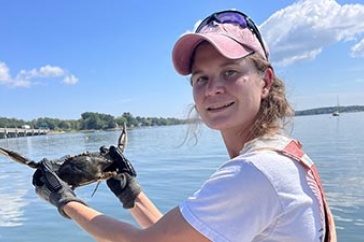UNH Researchers Discover First Pair of Mated Blue Crabs in Great Bay

UNH doctoral student Kelsey Meyer with large male blue crab in Great Bay Estuary. Courtesy photo
DURHAM, N.H.—Researchers at the University of New Hampshire have documented the first discovery of a pair of recently mated blue crabs in Great Bay Estuary (GBE), a finding that is expected to have serious impacts on the estuary’s ecosystem, particularly its fragile oyster population. Blue crabs have been captured in GBE since 2012 but this is the first time researchers have found compelling evidence that the crabs are actually mating.
“The arrival of blue crabs capable of creating a sustained population poses a new threat to oysters and other native GBE species,” said Bonnie Brown, professor, and chair of the department of biological sciences.
Doctoral student Alyssa Stasse and technician Emily Williams were checking traps set out by doctoral student Kelsey Meyer, who is monitoring the estuary’s invasive green crab population, when they found the two blue crabs and the mating proof: the female, which had recently molted, had distended turgid seminal receptacles with large sperm plugs, clear evidence of crustacean copulation.
“This new predator—which eats bivalves including clams and eastern oysters—brings the possibility of dramatic changes to the estuary ecosystem including how nutrients like nitrogen and phosphorus cycle between the physical environment and living organisms to keep both healthy and thriving,” said Brown. “Eastern oyster populations in the bay provide habitat and nutrient cycling services, and their numbers are estimated to be only about 10% of what they were in the 1980s. A breeding population of blue crabs would be really bad news.”
Gabriela Bradt, fisheries and aquaculture specialist for New Hampshire Sea Grant and UNH Cooperative Extension, is leading a new Great Bay National Estuarine Research Reserve and NH Sea Grant pilot crab monitoring project in GBE to establish a baseline and early detection of several species of concern, including blue crabs, as well as trophic interactions. The project also involves community engagement to begin mapping the distribution of the crabs both locally in New Hampshire and in the region.
Oysters and the oyster farming industry in GBE are already threatened by invasive green crabs. Meyer is studying the abundance, distribution and diet of green crabs in GBE, collecting data to gain a better understanding of where green crabs are, when they are there, what are they’re eating and how they interact with Great Bay’s oyster farms.
The scientific finding of the mated blue crabs has been submitted to Northeastern Naturalist, a journal that documents natural history of organisms in northeastern North America. The mating crabs were discovered during research projects funded primarily by a New Hampshire Agricultural Experiment Station Hatch grant, with additional funding from 2022 New Hampshire Sea Grant graduate research fellowships.
The University of New Hampshire inspires innovation and transforms lives in our state, nation and world. More than 16,000 students from all 50 states and 71 countries engage with an award-winning faculty in top-ranked programs in business, engineering, law, health and human services, liberal arts and the sciences across more than 200 programs of study. A Carnegie Classification R1 institution, UNH partners with NASA, NOAA, NSF and NIH, and received $260 million in competitive external funding in FY21 to further explore and define the frontiers of land, sea and space.
PHOTO FOR DOWNLOAD:
https://www.unh.edu/unhtoday/sites/default/files/media/kelsey_w_male_bc_on_boat.jpg
Caption: UNH doctoral student Kelsey Meyer with large male blue crab in Great Bay Estuary. Courtesy photo
Latest News
-
April 15, 2025
-
Research Finds Rural Americans Carry Heavy Burden Accessing Social Security Benefits and InformationMarch 27, 2025
-
March 25, 2025
-
March 17, 2025
-
March 12, 2025













































